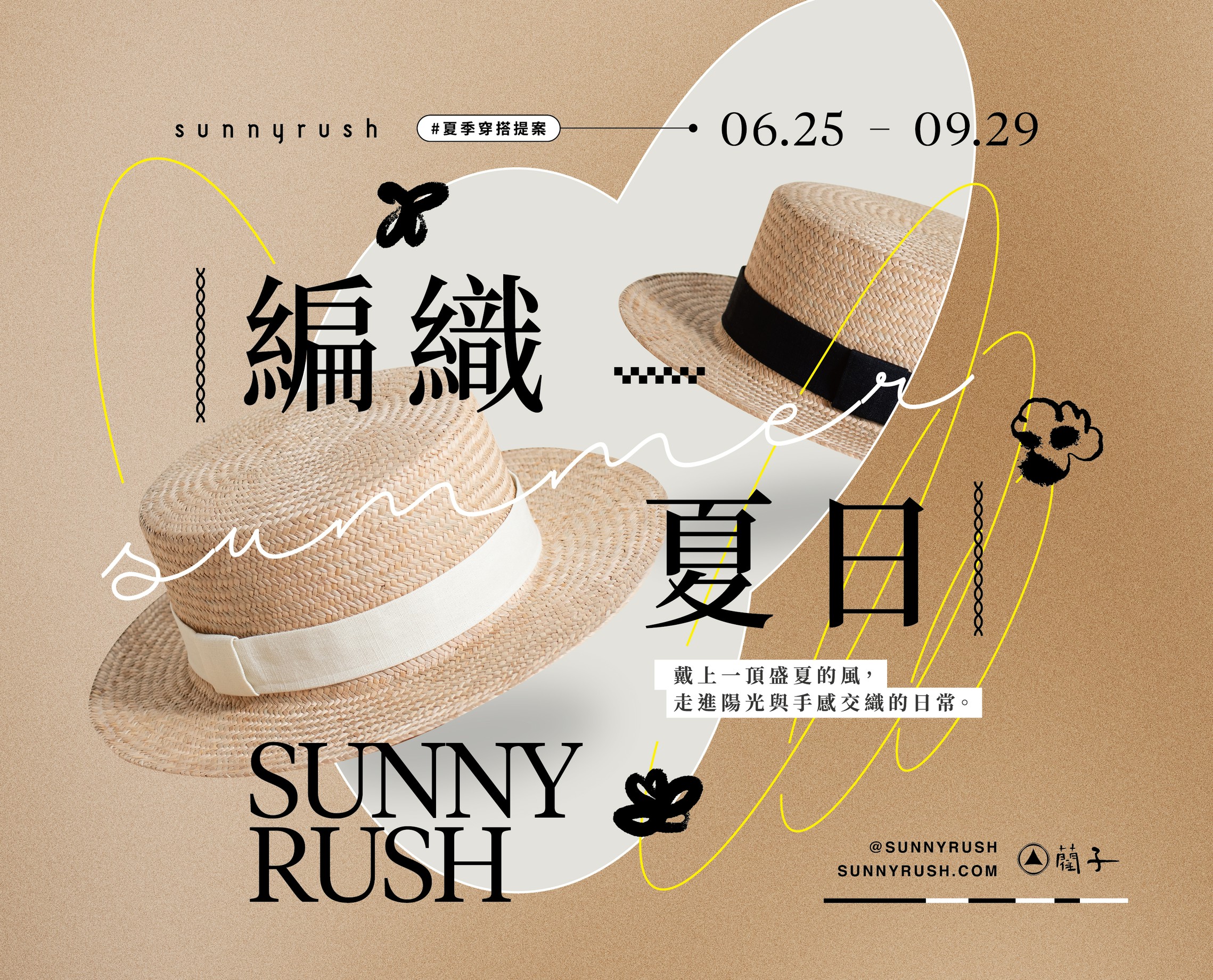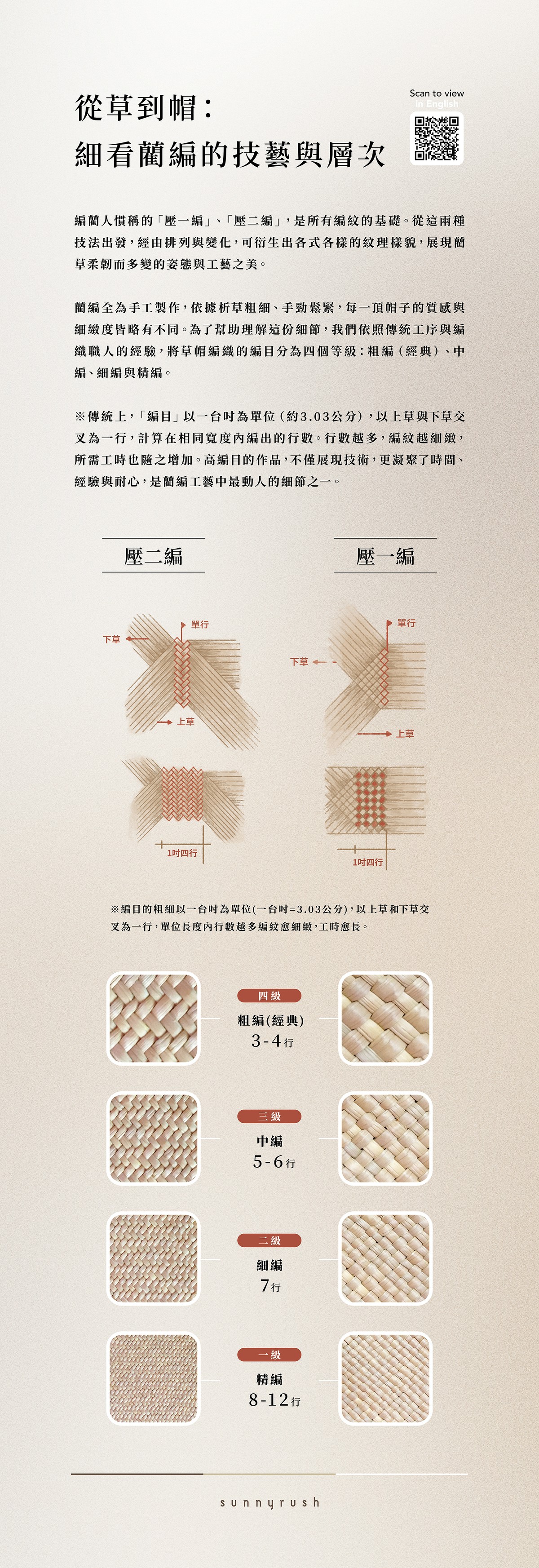
Weaving Summer
Put on a breeze of midsummer and step into a daily life where sunlight and craftsmanship intertwine.
The slightly salty sea breeze brushes over the rush, Summer quietly weaves the wind into every strand.
This time, we’ve come to Songshan, bringing handwoven rush hats, together with handcrafted brands to co-create one-of-a-kind hatbands and decorations.
A touch of your own personality is added to each hat, allowing traditional rush craft to ferment with creativity and bloom with new possibilities.
Try on a summer hat that belongs to you, feel the warmth of fine weaving at your fingertips, and let the gentle breeze carry you somewhere you've never been before.

Sunnyrush — The Child of Rush
Sunnyrush was born from the land of Yuanli, Miaoli, and from a deep dedication to traditional craftsmanship.
Since 2016, we have worked hand in hand with local artisans to breathe new life into a fading art, slowly shaping a form that belongs to this generation.
Sunnyrush is more than a brand that sells products; we are practitioners of sustainable craft. From design and production to collaboration and sales, we carefully weave together a complete industry chain — showcasing expertise, preserving culture, and helping artisans rediscover their pride and smiles.
Owning a piece of Sunnyrush is a way to walk alongside this beauty — allowing everyday life to connect gently with culture.

The Birth of a Rush Hat: A Landscape Woven by Memory, Hands, and Time
In 1897, Ms. Hong Yang from Tongxiao, Miaoli, married into Yuanli and was commissioned by the Japanese Governor-General’s Office to try weaving Western-style felt hats using rush. She not only succeeded but also became Taiwan’s first artisan to craft hats from rush.
This groundbreaking achievement made Hong Yang one of the most respected women under Japanese rule and marked the beginning of over a century of rush hat craftsmanship in Yuanli.
It was the late Meiji era, a time when Japan was actively promoting Westernization. Rush hats from Yuanli, in tune with this trend, unexpectedly became highly fashionable. By 1936, Taiwan's export of rush hats exceeded 16 million pieces, ranking third among exports, following sugar and rice.
After 1945, Yuanli’s rush hat industry entered a second golden age, expanding its market from Japan to major cities in China. Rush hats became everyday essentials. Around 1950, under the promotion of the Women’s League founded by Soong Mei-ling, rush scout hats became part of student uniforms, becoming a collective memory for many during their school years.
“My mother wove rush to pay for my school tuition.”
“One hat could be exchanged for several bushels of rice.”
Elders often say these words, not just as memories, but as expressions of deep gratitude. It was a time when mothers wove a future for their families with their own hands. Every rush hat was like a gentle pair of wings supporting a household.
Now, these time-honored skills reappear before us. A rush hat is not just a hat — it carries heritage, holds the memory of the land, and stands as a unique fashion symbol of Yuanli.
From Grass to Hat: The Craft and Layers of Rush Weaving
The techniques known as “One-over-One” and “One-over-Two,” as referred to by rush-weavers, form the foundation of all weaving patterns. From these two techniques, various textures and designs emerge through arrangement and variation, showcasing the flexibility, resilience, and beauty of rush craftsmanship.
Rush weaving is entirely handmade. The thickness of the sliced rush and the weaver’s tension produce subtle differences in texture and delicacy from hat to hat. To better understand these details, we categorize rush hat weaving into four grades based on traditional methods and artisans' experience: Thick Weave (Classic), Medium Weave, Thin Weave, and Ultra-Fine Weave.
Traditionally, the weaving density is measured by the Taiwanese inch (approx. 3.03 cm), counting the number of rows within that width. One row consists of one stalk crossing over another. The more rows per unit, the finer the weave, and the more time it requires. High-count weaves not only demonstrate advanced skill but also embody time, experience, and patience — among the most captivating aspects of rush weaving craftsmanship.
